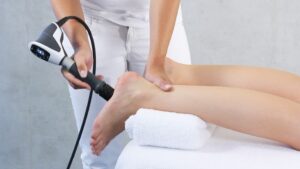A Breakthrough in Treating Foot Conditions

Introduction
Extracorporeal Pulse Activation Therapy (EPAT) is an advanced, non-invasive treatment that has revolutionized the management of various foot and ankle conditions. Utilizing acoustic sound waves, EPAT therapy stimulates the body’s natural healing processes, offering relief from pain and promoting tissue regeneration.
What is EPAT Therapy?
EPAT Extracorporeal Pulse Activation Technology treatment will stimulate a cellular expression and improve blood and lymph circulation and thus accelerate the healing response and tissue regeneration. Moreover, faster blood and lymph circulation may also stimulate collagen production and fibrotic tissue breakdown in the treatment regions. As a result, we expect to see improvements in both pain reduction and functionality.
How EPAT Therapy Works
- Consultation: A thorough evaluation by a podiatrist to determine if EPAT therapy is suitable for the patient’s condition.
- Treatment Sessions: The therapy involves directing acoustic waves to the injured area using a specialized device. Each session typically lasts between 5 to 15 minutes and is performed weekly or bi-weekly.
- Healing Process: The sound waves stimulate the formation of new blood vessels and improve blood flow, accelerating the healing process and reducing pain.
Conditions Treated with EPAT Therapy
EPAT therapy is effective in treating a variety of foot and ankle conditions, including:
- Plantar Fasciitis: Inflammation of the plantar fascia, causing heel pain.
- Achilles Tendinitis: Inflammation of the Achilles tendon, leading to pain and stiffness.
- Heel Spurs: Bony growths on the heel that cause discomfort.
- Morton’s Neuroma: Thickening of tissue around the nerves between the toes.
- Tendonitis in the Arch: Inflammation of the tendons in the arch of the foot.
Benefits of EPAT Therapy
- Non-Invasive: EPAT therapy is a non-surgical treatment, reducing the risks associated with invasive procedures.
- Quick Recovery: Patients can resume normal activities immediately after treatment, with no downtime required.
- High Success Rate: Studies have shown a high rate of patient satisfaction and significant improvement in symptoms.
- Minimal Side Effects: Some patients may experience mild discomfort, redness, or bruising, which typically resolves within a few days.
What to Expect During EPAT Treatment
During the treatment, patients may feel a slight tingling or tapping sensation as the sound waves are applied. The procedure is generally well-tolerated, and most patients experience significant pain relief and improved function after a few sessions.
